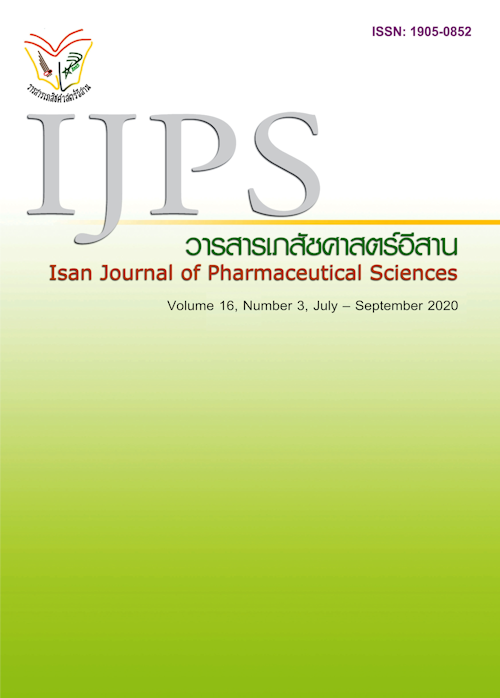RGB Colorimetric Method for the Quantitative Analysis of Levocetirizine Tablets
Main Article Content
Abstract
This study presented a simple and not time-consuming method coupled with a RGB colorimetric technique using the built-in function of mobile phone digital imaging devices for quantitative analysis. The method was based on the detection of color intensities and the evaluation of relationship between measured color and concentration of sample. Materials and methods: The proposed method was applied successfully to analyze levocetirizine (LCTZ) quantitatively in pharmaceutical tablet dosage forms using bromocresol green (BCG) as a coloring agent. Bromocresol green solution only is a blue color. When it reacted with levocetirizine it formed a yellow-green complex. The intensity of yellow-green complex color was depending on the concentration of drug sample. The complex solutions were transferred into standard glass cuvettes and then the images were recorded by mobile phone. The pixel array reader program was applied to evaluate the red-green-blue intensities (RGB scale) of the recorded images that were converted to the concentration which was calculated from the relationship of linear equation. Under the optimized condition, a calibration curve was established by the RGB scale and concentration of drug standard. Validation procedure was achieved concerning linearity, accuracy, and precision of developing method. Results: The proposed method obeyed Beer’s law and show linear relationship in concentration range of 2 - 40 µg mL-1 of levocetirizine with a good coefficient of determination (r2 = 0.9996). The limit of detection (LOD) and limit of quantification (LOQ) were found to be 1.64 and 4.96 µg mL-1, respectively. The common excipients used as additives in the pharmaceutical dosage form had shown no effect on the proposed method. The results acquired by the proposed method were compared favorably with those acquired by the reference method at a 95% confidence level with no significant difference (n=6). Conclusion: The developed method had shown accurate, precise, and reproducible. Moreover, this demonstrates the possibility of RGB colorimetric technique in the quantitative analysis of drugs in their pharmaceutical dosage forms with a simple procedure, low cost, and more applications for pharmaceutical analysis are expected to be use as an alternative method.
Article Details
In the case that some parts are used by others The author must Confirm that obtaining permission to use some of the original authors. And must attach evidence That the permission has been included
References
Almamoun AAA and Abdel AME. Ultraviolet spectrophotometric validation of the dissolution method for levocetirizine dihydrochloride tablets. Int.J.Multidiscip. Res. 2017; 4(12): 52-58.
Birendra Y and Sumit Y. Sensitive HPLC method for determination of the related substance of levocetirizine dihydrochloride in solid oral formulations. J. Pharm. Res. 2010; 3(12): 2817–2820.
Brozek JL, Bousquet J, Baena-Cagnani CE, Bonini S, Canonica GW, Casale TB, van Wijk RG, Ohta K, Zuberbier T, and Schunemann HJ. Allergic rhinitis and its impact on asthma (ARIA) guidelines: 2010 revision. J. Allergy Clin. Immunol. 2010; 126 (3): 466 – 476.
De Jong JM. Levocetirizine (dihydrochloride): Antihistaminicum. Geneesmiddlen Bulleetin 2002; 36(6): 70 – 71.
Hommoss R, Elzein H, and Haidar E. Determination of levocetirizine configurational stability in tablets using chiral HPLC method. Int. J. Pharm. Pharm. 2011; 3(2): 103–107.
ICH Expert Working Group. ICH harmonized tripartite guideline: Validation of analytical procedures: Text and methodology Q2 (R1). 2005.
Indian Pharmacopoeia 2010. 6th ed. New Delhi: The Indian pharmacopeia commission. 2010.
Issa YM, Sherif OE, and Abo DAS. Spectral studies on the ion-pairs of levocetirizine dihydrochloride and some triphenylsulphonephthaleines. Egypt. J. Anal. Chem. 2013; 22: 67–83.
Kehoe E and Penn R. Intriducing colourimetric analysis wioth camera phones and digital cameras; An activity for high school or general chemistry. J. Chem. Ed. 2019; 90(9)_: 1191-1195.
Labounmi B, Kruanetr S, and Rugensitagoon W. Simple method for determination of sodium using photogrammetry. Isan J. Pharm. Sci. 2018; 14(2); 122-130.
Ohta N and Robertson AR. Colorimetry: fundamentals and applications. The Atrium, Chichester, 2005.
Patel NK and Pancholi S. Spectrofluorimetric determination of the H1 blocker drug levocetirizine dihydrochloride based on its oxidation with cerium (IV) in bulk and pharmaceutical formulations. Int. J. Pharm. Tech. Res. 2011; 3(4): 2047–2052.
Raghu M and Basavaiah K. Optimized and validated spectrophotometric methods for the determination of levocetirizine in pharmaceuticals based on charge transfer reaction. J. Assoc. Arab Univ. Basic Appl. Sci. 2012; 12(1): 33 – 41.
Rathore AS. Sathiyanarayanan L and Mahadik KR. Development of validated HPLC and HPTLC methods for simultaneous determination of levocetirizine dihydrochloride and montelukast sodium in bulk drug and pharmaceutical dosage form. Pharm. Anal. Acta. 2010; 01(01): 1–6.
Shende P, Shah V, Ghodke D, Shah R, Patil SK, and Chougule DK. Validation of UV spectrophotometric method for estimation of levocetirizine dihydrochloride in bulk and pharmaceutical formulation. J. Pharm. Res. 2010; 3(10), 2386 – 2387.


